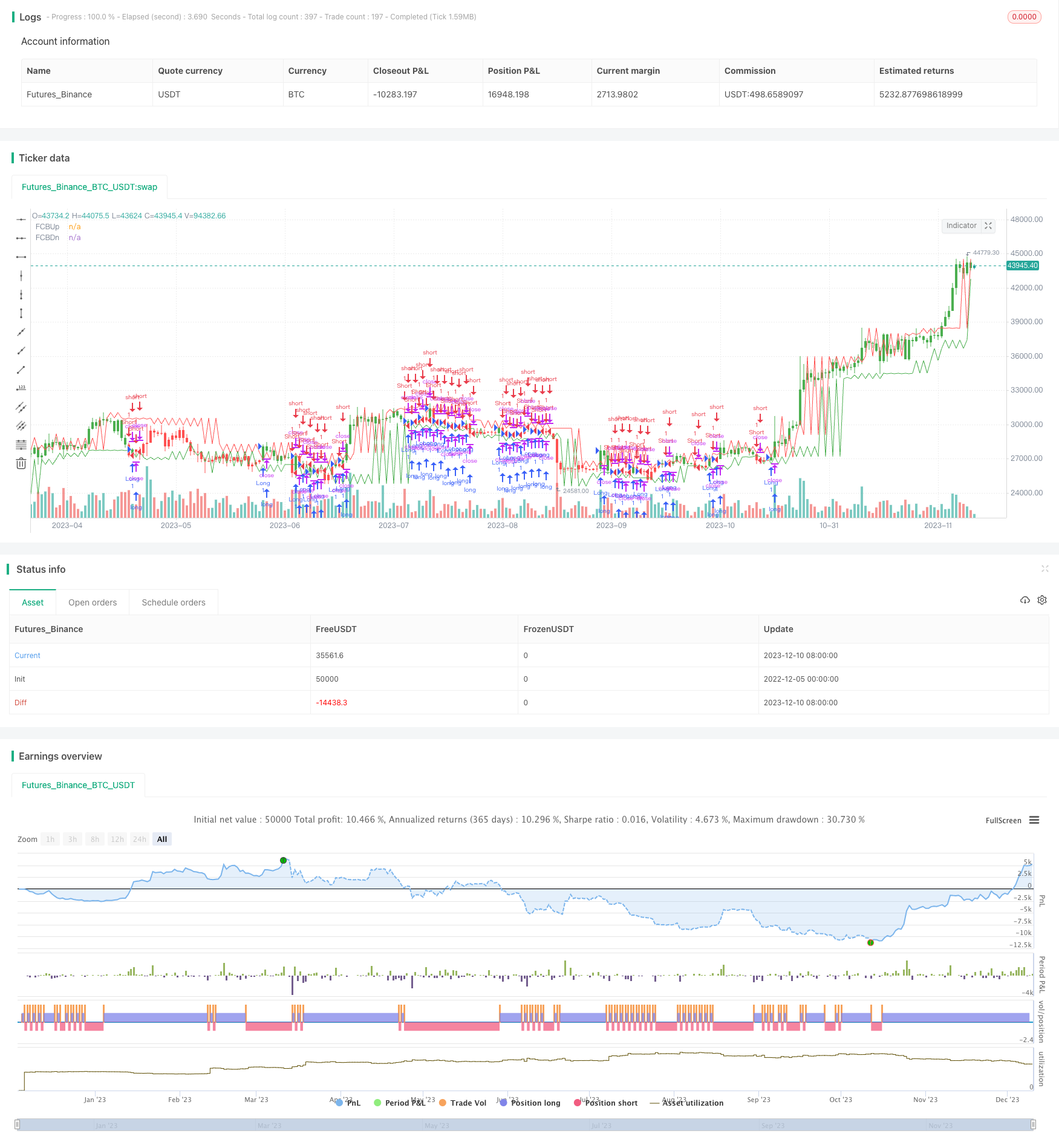
概述
该策略通过计算一定周期内的价格极大值点和极小值点,形成上下轨,判断当前价格位于上轨之上或者下轨之下时,进行长仓或者短仓操作。策略主要判定价格的趋势性,在趋势增强的时候进行交易。
策略原理
该策略的核心指标是计算一定周期内的价格极大值点和极小值点。具体计算方法是:
上轨:从左到右扫描周期内的K线,找到一个极大值高点,再判断其左边第1根K线到最左端和右边到最后第1根K线是否都是低于该极大值高点的,如果是则确认该点为区间顶点。
下轨:从左到右扫描周期内的K线,找到一个极小值低点,再判断其左边第1根K线到最左端和右边到最后第1根K线是否都是高于该极小值低点的,如果是则确认该点为区间底点。
重复这样的计算,可以得到一定周期内价格的上下轨。当价格上穿上轨时做多,下穿下轨时做空。这样就形成一个基于价格极值点判定趋势性的交易策略。
优势分析
该策略判断趋势的方式比较原始直接,通过价格极值判断趋势增强的部分,可以有效过滤震荡场景,避免在震荡中交易。策略交易信号产生的位置比较有优势,容易形成趋势追踪。此外,策略取信号的方式比较严格,可以减少错误信号。
风险分析
该策略取信号比较严格,可能会漏掉较多交易机会。此外,极值点需要一定时间积累形成,会比较滞后,需要适当优化参数。在参数不当时,也很可能会产生错误信号。
可以适当减少极值点判断的严格程度,允许一定程度上的波动,这样可以减少误判风险。此外可以结合其他指标进行确认,避免错误信号。
优化方向
该策略判断上下轨的周期可以适当优化,使其能够更好地捕捉趋势。此外判断极值点时的扫描区间也可以进行调整。
为减少错过交易机会的可能,可以适当放宽极值点的判断条件,允许一定幅度的波动。
可以尝试结合其他指标进行确认,如量能指标、移动平均线等,避免因单一指标判断而产生的错误信号风险。
总结
该策略通过价格极值点判断价格趋势特征的方式比较直接有效,可以有效过滤震荡,判断趋势增强的时机,从而进行趋势交易。策略优势在于信号产生位置好,可以追捕趋势。不足之处在于信号可能比较滞后,较难捕捉转折。通过参数以及条件的优化,该策略可以成为一个较为可靠的趋势判断工具。
/*backtest
start: 2022-12-05 00:00:00
end: 2023-12-11 00:00:00
period: 1d
basePeriod: 1h
exchanges: [{"eid":"Futures_Binance","currency":"BTC_USDT"}]
*/
//@version=2
////////////////////////////////////////////////////////////
// Copyright by HPotter v1.0 19/02/2018
// Stock market moves in a highly chaotic way, but at a larger scale, the movements
// follow a certain pattern that can be applied to shorter or longer periods of time
// and we can use Fractal Chaos Bands Indicator to identify those patterns. Basically,
// the Fractal Chaos Bands Indicator helps us to identify whether the stock market is
// trending or not. When a market is trending, the bands will have a slope and if market
// is not trending the bands will flatten out. As the slope of the bands decreases, it
// signifies that the market is choppy, insecure and variable. As the graph becomes more
// and more abrupt, be it going up or down, the significance is that the market becomes
// trendy, or stable. Fractal Chaos Bands Indicator is used similarly to other bands-indicator
// (Bollinger bands for instance), offering trading opportunities when price moves above or
// under the fractal lines.
//
// The FCB indicator looks back in time depending on the number of time periods trader selected
// to plot the indicator. The upper fractal line is made by plotting stock price highs and the
// lower fractal line is made by plotting stock price lows. Essentially, the Fractal Chaos Bands
// show an overall panorama of the price movement, as they filter out the insignificant fluctuations
// of the stock price.
//
// You can change long to short in the Input Settings
// WARNING:
// - For purpose educate only
// - This script to change bars colors.
////////////////////////////////////////////////////////////
fractalUp(pattern) =>
p = high[pattern+1]
okl = 1
okr = 1
for i = pattern to 1
okl := iff(high[i] < high[i+1] and okl == 1 , 1, 0)
for i = pattern+2 to pattern*2+1
okr := iff(high[i] < high[i-1] and okr == 1, 1, 0)
res = iff(okl == 1 and okr == 1, p, res[1])
res
fractalDn(pattern) =>
p = low[pattern+1]
okl = 1
okr = 1
for i = pattern to 1
okl := iff(low[i] > low[i+1] and okl == 1 , 1, 0)
for i = pattern+2 to pattern*2+1
okr := iff(low[i] > low[i-1] and okr == 1, 1, 0)
res = iff(okl == 1 and okr == 1, p, res[1])
res
strategy(title="Fractal Chaos Bands", overlay = true)
Pattern = input(1, minval=1)
reverse = input(false, title="Trade reverse")
xUpper = fractalUp(Pattern)
xLower = fractalDn(Pattern)
pos = iff(close > xUpper, 1,
iff(close < xLower, -1, nz(pos[1], 0)))
possig = iff(reverse and pos == 1, -1,
iff(reverse and pos == -1, 1, pos))
if (possig == 1)
strategy.entry("Long", strategy.long)
if (possig == -1)
strategy.entry("Short", strategy.short)
barcolor(possig == -1 ? red: possig == 1 ? green : blue )
plot(xUpper, color=red, title="FCBUp")
plot(xLower, color=green, title="FCBDn")